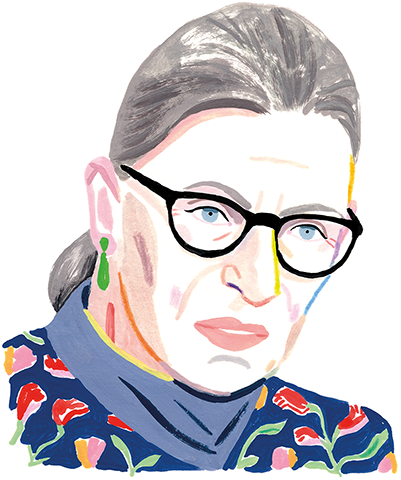“An aberration.”
That was U.S. Supreme Court Justice Ruth Bader Ginsburg’s response to the question that Director of Dining Services Joseph Flueckiger posed to her on Oct. 3: “How do you think people will characterize this period in American history?”
This assessment came during a conversation with Amherst President Biddy Martin that drew 1,600 students, faculty and staff. Justice Ginsburg is the third sitting justice to speak at Amherst since 2004; the others are the late Justice Antonin Scalia and Justice Sonia Sotomayor.
The anecdote-sprinkled discussion was held in an almost unrecognizable Coolidge Cage, which had been elegantly carpeted and decorated for the occasion. The choice of venue illustrated the event’s significance: Justice Ginsburg is the first high-profile figure to speak in the Cage since President John F. Kennedy on Oct. 26, 1963.
Introducing her to the crowd was one of her former law clerks, Andrew J. Nussbaum ’85, now chair of Amherst’s board of trustees. Of the day-to-day experience of working for the justice, he said, “It was four years of Amherst College rolled into one. It was the liberal arts put to the true test.”
The justice discussed her experiences over a six-decade career. Among many other topics, the conversation touched on her education at Cornell (“Nabokov was a marvelous teacher,” she said), the high court as a reactive institution (“The Supreme Court doesn’t have an agenda of its own”) and whether she was surprised by the nickname “Notorious RBG,” a nod to the late rapper known as The Notorious B.I.G. (“I wasn’t at all surprised. The two of us had something very important in common—that is, we were both born and bred in Brooklyn.”)
The justice spoke about some landmark Supreme Court decisions of her lifetime, including Roe v. Wade (in 1973, before she was a justice), which protects the right to have an abortion; Citizens United v. Federal Election Commission, which concerns campaign finance; and United States v. Virginia, which struck down the male-only admission policy of the Virginia Military Institute (VMI).
In the VMI case, she wrote the majority decision, with Scalia writing the sole dissent. As an example of the collegiality and friendship she shared with the late justice, she described how Scalia gave her his dissent early so she’d have proper time to respond: “It absolutely ruined my weekend when I read it, but I was glad to have an extra few days to come up with responses.”
One of her most thought-provoking answers came near the end, when Martin asked whether there will ever be an Equal Rights Amendment to the Constitution. “I hope so,” Justice Ginsburg said, noting that every constitution worldwide written in the past 50 years contains language about equal rights for women. Even if it’s just a symbol, she argued, “it’s a very important symbol.”
She added, “I think it’s time for us to catch up.”

